Anthony Bourdain is fascinated by the beauty of India, a land of color, aroma, kind people and delicious cuisine. Anthony makes a culinary pilgrimage to Rajasthan in the northwest corner of the subcontinent where he explores life in the region. From gorgeous sights to enticing smells, Anthony explores the magical and delicious offerings of Rajasthan.
Introduction:
Rajasthan
Rajasthan is the land of Rajasthanis ("the land of kings" or "the land of colors") and is the largest state of the Republic of India by area. It encompasses most of the area of the large, inhospitable Great Indian Desert (Thar Desert).
The history of human settlement in the north Indian state of Rajasthan dates back to about 5,000 years ago, with parts of North Rajasthan at the heart of the Indus Valley Civilization, one of the world's first and oldest civilizations. This region was long known as Gurjaratra—that is country protected or ruled by the Gurjars—before it came to be called Rajputana, early in the Muslim period. It is also the famous land of the Rajput warriors, renowned for their heroic deeds on the battlefield. The majestic palaces, forts and other architectural edifices of historical significance tell interesting tales of the Rajput rulers who once exercised sovereignty over this northwestern state of India.
Demographics:
Rajasthan was formed in March 1949, when all erstwhile princely states ruled by Rajputs, known as Rajputana, merged into the Dominion of India. Today, Rajasthan has a mainly Rajasthani population. Hindus account for 88.8% of the population. Muslims make up 8.5%, Sikhs 1.4% and Jains 1.2% of the population. The state of Rajasthan is also populated by Sindhis, who came to Rajasthan from Sindh province (now in Pakistan) during the India-Pakistan separation in 1947. Rajasthani and Hindi are the most widely used languages in Rajasthan.
Economy:
The main industries are mineral based, agriculture based, and textiles. Endowed with natural beauty and a great history, tourism is a flourishing industry in Rajasthan and accounts for 8% of the state's domestic product. Rajasthan attracted 14% of total foreign visitors during 2009-2010, which is fourth highest in all states of India. Rajasthan is famous for the majestic forts, intricately carved temples and decorated havelis, which were built by Rajput kings in previous ages, they were the soul of pre-Muslim era Rajasthan. Jantar Mantar, Dilwara Temples, Chittorgarh Fort, Lake Palace, City Palaces, Jaisalmer Havelis, and its Jaipur (the "Pink City") are part of the true architectural heritage of India. They rank among the most preferred destinations in India for many tourists both Indian and foreign. Many old and neglected palaces and forts have been converted into heritage hotels.
Cuisine:
Rajasthani cuisine was influenced by both the war-like lifestyles of its inhabitants and the availability of ingredients in this arid region. Food that could last for several days and could be eaten without heating was preferred. Scarcity of water and fresh green vegetables have all had their effect on the cooking.Rajasthan is known for tough people and tough food. The typical Rajasthani cuisine is called Thali, which consists of roti (a flat bread made from wheat flour), daal or, chaval (rice), and shaak (sabzi; a dish made up of different combinations of vegetables and spices, which may be stir fried, spicy or sweet). Cuisine varies in flavour and heat, depending on taste.
Udaipur
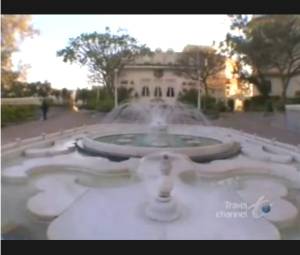 Udaipur, also known as the "City of Lakes", is a city in the state of Rajasthan. Udaipur has a population of 550,000, making it the fourth largest city of Rajasthan.
Udaipur, also known as the "City of Lakes", is a city in the state of Rajasthan. Udaipur has a population of 550,000, making it the fourth largest city of Rajasthan.
Udaipur was the historic capital of the former kingdom of Mewar in Rajputana Agency. Apart from its glorious history, culture and scenic locations, it is also known for its Rajput-era palaces. The City Palace was built by the Maharana Udai Mirza Singh as the capital of the Sisodia Rajput clan in 1559, after he moved from Chittor. It was built in a flamboyant style and is considered the largest of its type in Rajasthan, a fusion of the Rajasthani and Mughal architectural styles, and was built on a hill top that gives a panoramic view of the city and its surroundings, including several historic monuments such as the Lake Palace in Lake Pichola, the Jag Mandir on another island in the lake, the Jagdish Temple close to the palace, the Monsoon Palace on top of an overlooking hillock nearby and the Neemach Mata temple.
The James Bond movie Octopussy featured the Lake Palace and the Monsoon Palace. The subsequent publicity resulted in the epithet of Udaipur as the "Venice of the East". Conceived in romance, the palace was built in 1746 by Maharana Jagat Singh II, 62nd successor to the royal dynasty of Mewar—believed to be descendants of the Sun God. It is claimed that Jag Mandir of Udaipur was the inspiration behind Shahjahan's creation of the Taj Mahal. Udaipur is mentioned under the spelling Oodeypore in Rudyard Kipling's The Jungle Book as the birthplace of Bagheera, the fictional panther in the king's Menagerie.
Udaipur is one of the favorite tourist destinations in India. The beautiful lakes, palaces and lively workspaces and culture attract numerous foreign and domestic visitors. Many of the palaces have been converted into luxury hotels. Udaipur was named "Best City of the World" in 2009 by Travel and Leisure. Many celebrities, including film stars, business families, and politicians chose Udaipur to hold marriage ceremonies and parties.
Jaisalmer
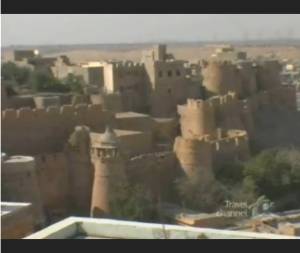 Jaisalmer, nicknamed "The Golden City", stands on a ridge of yellowish sandstone, crowned by a fort, which contains the palace and several ornate Jain temples. Many of the houses and temples are finely sculptured. Jaisalmer is almost entirely a sandy waste, forming a part of the great Indian desert. It lies in the heart of the Thar Desert and has a population of about 78,000.
Jaisalmer, nicknamed "The Golden City", stands on a ridge of yellowish sandstone, crowned by a fort, which contains the palace and several ornate Jain temples. Many of the houses and temples are finely sculptured. Jaisalmer is almost entirely a sandy waste, forming a part of the great Indian desert. It lies in the heart of the Thar Desert and has a population of about 78,000.
Jaisalmer is named after its founder Rao Jaisal a Rajput king. The majority of the inhabitants of Jaisalmer are Bhati Rajputs, named for Bhati, who was renowned as a warrior. During the Islamic invasion of India, Jaisalmer escaped direct Muslim conquest due to its geographical situation in the desert region. Jaisalmer was one of the last states to sign a treaty with the British. During the British Raj, Jaisalmer was the seat of a princely state of the same name, ruled by the Bhati clan of Rajputs.
Skirmishes between India and Pakistan gave Jaisalmer a strategic importance and made it serviceable as an army supply depot. Later, the Rajasthan Canal served to revive the surrounding desert areas. Roads and railroads were then built, knitting the hitherto remote town with the rest of Rajasthan.
Tourism is a major industry in Jaisalmer. Musicians and dancers are also a major cultural export from Jaisalmer to the rest of the world. Manganyar musicians have played the world over, and Queen Harish, the dancing desert drag queen, is touring the world and has featured in international movies.
Episode Recap:
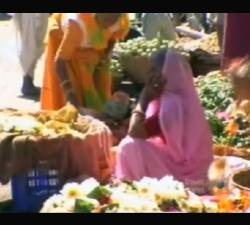 Anthony Bourdain starts his culinary pilgrimage in the Rajasthani city of Udaipur, where he's been invited to attend a meal prepared by the local maharana, or prince of Udaipur, in the celebration of his son's 21st birthday. But first, Anthony visits the town to experience the local life.
Anthony Bourdain starts his culinary pilgrimage in the Rajasthani city of Udaipur, where he's been invited to attend a meal prepared by the local maharana, or prince of Udaipur, in the celebration of his son's 21st birthday. But first, Anthony visits the town to experience the local life.
New Bapu Bazaar: Anthony explores the New Bapu Bazaar, one of India's many outdoor markets. Locals can purchase everything from fabrics, shoes, local perfumes and jackets, all in one location. He finds the everyday colors of the food and the clothes extraordinarily bright and electric. Anthony confesses that while he's normally disdainful of vegetarians, India is one of the few countries in which he cheerfully eats vegetarian.
Natraj Thali Restaurant: Anthony stops at Natraj Thali Restaurant in the Natraj Hotel. He joins owners Jatim and Jaynat, who are not only full-time restaurateurs, but also full-time graduate students. They sit down to traditional all-you-can-eat Thali vegetarian meal for only $1. They dine on lentils, okra, potatoes, pickles, curds, beans, and other Rajasthani staples served with a crisp bread called papadam, as well as a softer bread called chapati. Anthony admits that the meal is the best vegetarian meal he can remember ever having.
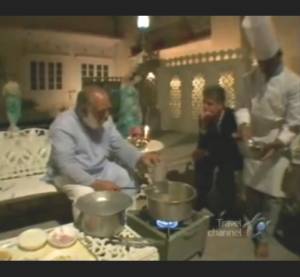 Lake Palace: Anthony goes to the lake palace of Maharana Mewar, the Prince of Udaipur and heir to a centuries-old Rajasthani dynasty. A Maharana is a variation on the Indian royal title Maharaja, also meaning "Great king" in Hindi. Not only is the Maharan a renowned cook, but he is also a renowned master of traditional Mawari dishes, the cuisine of southern Rajasthan. Like any head chef, the Maharana farms out the prep work among his other chefs. Anthony joins the Maharan on his lakeview terrace, where he prepares some curry lamb especially for Anthony.
Lake Palace: Anthony goes to the lake palace of Maharana Mewar, the Prince of Udaipur and heir to a centuries-old Rajasthani dynasty. A Maharana is a variation on the Indian royal title Maharaja, also meaning "Great king" in Hindi. Not only is the Maharan a renowned cook, but he is also a renowned master of traditional Mawari dishes, the cuisine of southern Rajasthan. Like any head chef, the Maharana farms out the prep work among his other chefs. Anthony joins the Maharan on his lakeview terrace, where he prepares some curry lamb especially for Anthony.
Curry is a generic description used throughout Western culture to describe a variety of spiced dishes. Three spices found in most curry powders are turmeric, coriander, and cumin; a wide range of additional spices may be included depending on the foods being included (meats, fish, lentils, rice, etc.). Typical Rajasthani curry dishes include Kadhi, Papad ki sabji, and Jaipuri. Ghee is also an essential ingredient in making curry dishes. Ghee is a class of clarified butter that originated in South Asia and is commonly used in South Asian (Indian, Bangladeshi, Nepali and Pakistani) cuisine.
Royal Birthday Extravaganza: Anthony returns to the lake palace to attend the meal celebrating the Maharana's son's 21st birthday. There is no shortage of ceremony and spectacle as the Maharana's son makes a grand appearance. After the formalities, the party begins with extravagant dance performances that would rival the best Bollywood movie. A large barbecue grills up all kinds of kebabs, and a large buffet about a block long features a vast assortment of Indian delicacies. Then there's the birthday cake and a fireworks display.
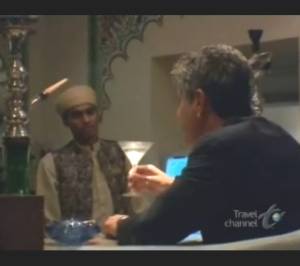 Taj Lake Palace Hotel Bar: After the party, Anthony hops a boat out to the Taj Lake Palace Hotel Bar for a nightcap. The bar is inside the famous Taj Lake Palace hotel situated in the middle of Lake Pichola, and is a hot spot for the celebrities and tourists. The bartender recommends Anthony tries their famous Bombay Sapphire martini made with a few ice cubes, a couple of ounces of Bombay Sapphire Gin, a dash of vermouth, and a gorgonzola and mint stuffed olive.
Taj Lake Palace Hotel Bar: After the party, Anthony hops a boat out to the Taj Lake Palace Hotel Bar for a nightcap. The bar is inside the famous Taj Lake Palace hotel situated in the middle of Lake Pichola, and is a hot spot for the celebrities and tourists. The bartender recommends Anthony tries their famous Bombay Sapphire martini made with a few ice cubes, a couple of ounces of Bombay Sapphire Gin, a dash of vermouth, and a gorgonzola and mint stuffed olive.
The Taj Lake Palace is a dream of white marble and mosaic glistening in the moonlight, very reminiscent of the most beautiful tourist cliché in the world; the Taj Mahal. Set against the backdrop of the majestic Aravalli Mountains on one side of the lake, and lofty palaces on the other, the Taj Lake Palace spreads across a four-acre island—an almost surreal vision in marble. The Royal Butlers, descendents of the original palace retainers, look after all contemporary comforts and ensure that all guests are treated like royalty.
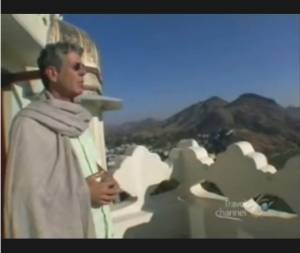 Devi Garh Palace: Anthony heads to the small enchanting village of Dilwara where he has suite at the exotic Devi Garh Palace. In a scene right out of the MTV Cribs, Anthony takes us on a tour of his impressive palatial suite, including his spectacular view of the surrounding valley.
Devi Garh Palace: Anthony heads to the small enchanting village of Dilwara where he has suite at the exotic Devi Garh Palace. In a scene right out of the MTV Cribs, Anthony takes us on a tour of his impressive palatial suite, including his spectacular view of the surrounding valley.
The Devi Garh Palace is a heritage hotel and resort, built in the 18th century. Nestled in the Aravalli hills, today it is one of India's leading luxury hotels. Frommer's Review, while calling it "the best hotel on the subcontinent", stated that "Devi Garh is more than beautiful, it is inspiring." In 2008, it was featured in Lifestyle Channel Discovery Travel and Living series; other two Indian hotels that made it to the list of 55, were the Taj Lake Palace and the Rambagh Palace in Jaipur.
Grocery Shopping: Anthony joins is friend Vimal Dhar and his family on a shopping trip in Dilwara for the ingredients for a typical Kashmiri feast that evening. Originally from Kasmi, Vimal is one of India’s renowned chefs and is now based at the Devi Garh Palace.
Kashmiri-style Dinner: Back at Vimal's home, Anthony babysits Vimal's somewhat hyperactive toddler, while Vimal and his wife toil away in the kitchen. He's good deed is rewarded with feast of typical Kashmiri dishes: radish in yogurt, lotus stems in yogurt, turnips and cottage cheese, goat shanks, fritters made from lotus stems, and potatoes; a delectable mix of color and texture. Everything goes with rice, and it's slightly spicy. They end the meal with a dessert made with reduced milk and cardamom.
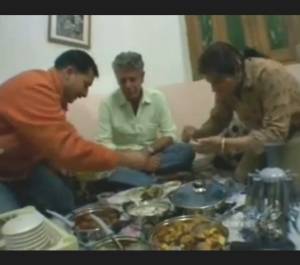
Kashmiri cuisine has evolved over hundreds of years. The first major influence was the food of the Kashmiri Pandits. The food usually uses a lot of yogury, oils and spices as such turmeric, asafoetida, dried powdered ginger, cinnamon, cardamoms, and cloves, but avoids onion, garlic, tomatoes, and chicken. An equal emphasis is laid on vegetarian and non-vegetarian dishes, although a bias for non-vegetarian dishes certainly exists. The cuisine was then influenced by the cultures which arrived with the invasion of Kashmir by Timur from the region of modern Uzbekistan, and subsequently by the cuisines of Central Asian, Persia, and Afghanistan. The most notable ingredient in Kashmir cuisine is mutton. There are also the Balti curries that were originally brought by Pakistani immigrants from the Baltistan region of Pakistan-administered Kashmir.
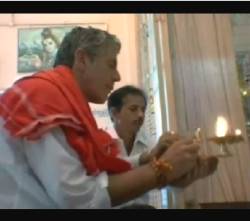 Jaipur Ashram: At the suggestion of a friend, Anthony visits an ashram in Jaipur. Guru Sunil Vyas, the resident astrologer and spiritual leader of the ashram, uses only the latest modern technology and software during his consultations. After his reading, Anthony hangs around long enough to participate in a puja.
Jaipur Ashram: At the suggestion of a friend, Anthony visits an ashram in Jaipur. Guru Sunil Vyas, the resident astrologer and spiritual leader of the ashram, uses only the latest modern technology and software during his consultations. After his reading, Anthony hangs around long enough to participate in a puja.
Traditionally, an ashram is a spiritual hermitage. Additionally, today the term ashram often denotes a locus of Indian cultural activity such as yoga, music study or religious instruction, the moral equivalent of a studio or dojo. An ashram would typically, but not always, be located far from human habitation, in forests or mountainous regions, amidst refreshing natural surroundings conducive to spiritual instruction and meditation. The residents of an ashram regularly performed spiritual and physical exercises, such as the various forms of Yoga. Other sacrifices and penances, such as Yajnas were also performed. Many ashrams also served as Gurukuls or residential schools for children.
Desert Bus Trip: Anthony hops on top of a bus and heads to the desert city of Jaisalmer to walk among the sand dunes and search for his "inner Tony". Even though it's a 357 mi ride, Anthony says it's the happiest he's been in India, with the wind in his hair and friendly strangers playing music and offering him fruit. Along the way, the bus periodically stops for some roadside food and chai, and the opportunity to smoke a beedi—a thin, South Asian cigarette filled with tobacco flake and wrapped in a tendu leaf tied with a string at one end.
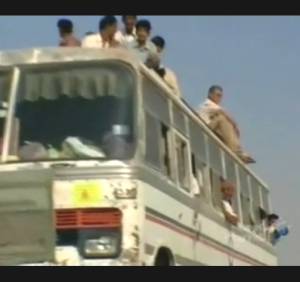
Masala chai, or known simply as chai, is a beverage made by brewing tea with a mixture of aromatic Indian spices and herbs. Most chai found in restaurants or homes incorporates one or more of the following: cardamom, cinnamon, ginger, fennel seeds, peppercorn, and cloves. For a snack, there's dahi kachori, a spicy snack popular in Rajasthan. It is usually a round flattened ball made of fine flour-filled with a stuffing of baked mixture of yellow moong dal or Urad Dal (crushed and washed horse beans), besan (crushed and washed gram flour), black pepper, red chili powder, salt and other spices. Additionally, the Pyaaz ki Kachori (Onion Kachori) is very famous. Another popular roadside snack consists of yogurt or curd with fried spicy, crispy wheat cake.
Marudhar Restaurant: Anthony enjoys an late meal at Marudhar Restaurant, a typical roadside pit stop for truckers and bus passengers making the long run across the arid desert. The menu is all vegetarian. Anthony starts with two parathas—one stuffed with potato, the other with a cheese called paneer. Then he moves on to a number of dishes, including tandoori, for which the restaurant is best known. He also tries chach, a traditional Indian beverage made of made of curds and mixed with salt, cumin, and coriander.
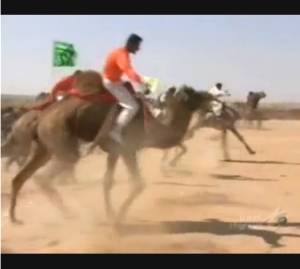 Jaisalmer Desert Festival: Anthony attends the much anticipated Jaisalmer Desert Festival. Every years the festival is held over three days in January/February. This is the best time to visit Jaisalmer to witness performing arts like Kalbelia dances—one of the most sensuous dance forms of Rajasthan, performed by the Kalbelia tribe—and folk songs and music. There's also camel races, turban tying competitions and the best moustache competition, as well as the traditional game of kabaddi.
Jaisalmer Desert Festival: Anthony attends the much anticipated Jaisalmer Desert Festival. Every years the festival is held over three days in January/February. This is the best time to visit Jaisalmer to witness performing arts like Kalbelia dances—one of the most sensuous dance forms of Rajasthan, performed by the Kalbelia tribe—and folk songs and music. There's also camel races, turban tying competitions and the best moustache competition, as well as the traditional game of kabaddi.
Kabaddi is a team contact sport that originated in South Asia BCE, as a form of recreational combat training. Two teams occupy opposite halves of a field and take turns sending a "raider" into the other half, in order to win points by tagging or wrestling members of the opposing team; the raider then tries to return to his own half, holding his breath and chanting "kabaddi, kabaddi, kabaddi" during the whole raid. Tagged members are "out" and temporarily sent off the field. Defenders must form a chain by linking hands; if the chain is broken, a member of the defending team is sent off. The goal of the defenders is to stop the raider from returning to the home side before taking a breath.
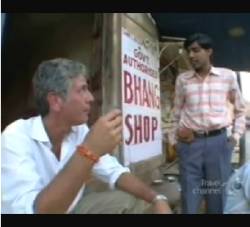 Bhang Shop: After a day at the desert festival, Anthony heads into the fort's city in search of a Bhang Shop for some bhang lassi. Anthony orders the "full-power, 24-hour no-toilet/no-shower" strength version of bhang lassi, as well as some baked chocolate-flavored bhang products to tie him over in anticipation of his impending munchies.
Bhang Shop: After a day at the desert festival, Anthony heads into the fort's city in search of a Bhang Shop for some bhang lassi. Anthony orders the "full-power, 24-hour no-toilet/no-shower" strength version of bhang lassi, as well as some baked chocolate-flavored bhang products to tie him over in anticipation of his impending munchies.
Bhang lassi is a special lassi that contains bhang, a liquid derivative of cannabis (marijuana), which has effects similar to other eaten forms of cannabis. It is legal in many parts of India and mainly sold during Holi, when pakoras containing bhang are also sometimes eaten. Rajasthan is known to have licensed bhang shops where one can buy bhang products and drink bhang lassis. However, the term "bhang lassi" is more often a misnomer, as it is almost always made with thandai, a drink made with either milk or water, crushed ice, sugar, and other ingredients such as kesar pista, thandai syrup, saffron, ground almonds, spices, gound melon and poppy seeds.
When he wakes up the following morning in the desert, having slept on a sand dune, he concludes that whether you wake up in a maharana's palace, a swank hotel, a cheap hostel, or a sand dune in the desert, you're grateful to be alive and still in India because of all the places in the world, India has perhaps the biggest heart and the most beautiful things to see.
Episodes:
 |
ARGENTINA: From the Tango to paragliding to cattle rustling to trekking along icy glaciers, Anthony experiences it all. |
 |
AUSTRALIA: Melbourne has been described as San Francisco without the fog. Anthony is off to discover what makes it so special. |
 |
BERLIN: Anthony finds himself in Berlin, a city that is for him both good and evil, Eastern and Western, repulsive and appealing. |
 |
BRAZIL: Some say São Paulo feels like LA threw up on NYC. But Anthony's back for the great food and its welcoming people. |
 |
CALCUTTA & BOMBAY: Anthony revisits his love for India's vibrant culture, cuisine & communities with a trip to Kolkata & Mumbai. |
 |
COLOMBIA: A bright and beautiful country that has gone from drug capital to food capital. Anthony explores its unique cuisine. |
 |
EGYPT: Anthony skips the long lines and tour buses, and visits with Egyptian locals to get a taste for what it means to be Egyptian. |
 |
GHANA: Anthony heads to Ghana, West Africa, a land of old forts and slave castles, and a culture filled with great food and music. |
 |
GREEK ISLES: Anthony is on a culinary odyssey to discover if Greece really does have the world's healthiest diet. |
 |
HONG KONG: A wonder-land of colors, lights and speed, a perfect marriage of modern and traditional, and home to great Asian cuisine. |
 |
IRELAND: Ireland's steeped in history and traditions, both oral & written. Anthony dispels the myths that it has the worst food on the planet. |
 |
JAMAICA: Jamaica is a vibrant, colorful land full of resorts and reggae music. Anthony is there to uncover the lesser-known Jamaica. |
 |
KOREA: Anthony gives in to his employee's pressure to visit Korea and, next thing you know, they're in Seoul and the adventure begins. |
 |
MEXICO: Carlos, a head chef in NYC and good friend, gives Anthony a culinary tour of his hometown Puebla and nearby Mexico City. |
 |
OSAKA (Japan): Anthony learns all about kuidaore, which means to bankrupt oneself with extravagance in food and drink! |
 |
PARIS: In this very first episode of the series, Anthony heads to the "City of Light" to show, at least the Americans, why the French don't suck. |
 |
PERU: Anthony is on a mission to obtain personal enlightenment in a land of ancient culture, rich cuisine, and vibrant people. |
 |
QUEBEC (Canada): Anthony is off to Québec to indulge in one of his most hedonistic pleasures–foie gras (fatty duck liver). |
 |
ROME: Anthony adopts the mindset of the Roman people–living a simple life and eating fresh, seasonal ingredients. |
 |
RUSSIA: Anthony explores Russia, where the food is hearty. Along the way he meets a former Cold War spy and Miss Russia. |
 |
SHANGHAI (China): Anthony is back in China. From Shanghai to Tibet, he searches for the mythical Shangri-La. |
 |
SICILY: Anthony starts his gastronomic tour through Sicily in style by sharing a spleen sandwich with Sicily's president. |
 |
SINGAPORE: Singapore is serious about food and offers up a cuisine like no other. Anthony dives in head-first. |
 |
SPAIN: According to Anthony, outside of Asia, Spain is the single greatest place for culinary achievement in the world. |
 |
TOKYO: Anthony is off to Tokyo in search of the relationship between a perfect piece of sushi and a perfect knife blade. |
 |
TUSCANY: Anthony travels to the beautiful Tuscan countryside to visit with friends and enjoy some homemade pasta that's out of this world. |
 |
URUGUAY: Anthony and his brother are on a mission to connect with their roots in Uruguay after learning that Bourdains once settled here. |
 |
VANCOUVER (Canada): Anthony visits Vancouver, home to a thriving film industry, gorgeous scenery, and an evolving food scene. |
Contact Us | Shop | Sitemap | Join Our Team | Investors | Advertise | Web Design Services
Community | Foodies' Choice | Meetup Groups | Chat | Blogs | Forums | Submit Your Site | Resources
